Detailed System Analysis and Design Report for Fitness Super-Centre
VerifiedAdded on 2021/01/02
|29
|6950
|166
Report
AI Summary
This report presents a comprehensive system analysis and design for the 'You Can Fit In' fitness super-centre. It begins with an introduction to system analysis and design, emphasizing the importance of integrating business information systems with operational activities. The report analyzes the business case, outlining the organization's objectives and the need for a new information system to manage the super-centre's operations, which includes fitness training, gym services, and additional services like a store for nutritional and sports accessories, child fitness programs, and swimming. The report details the proposed functionality of the new system, including web-based access, high storage capacity, and secure features. It also outlines the functions the new system might fulfill, such as managing accounts, classes, staff details, and stocks. A system vision document is provided, including design constraints, assumptions, and system usage scenarios. The report also includes a table of tasks, dependencies, and durations, along with a Gantt chart and critical path analysis. Risk assessments and anticipated benefits, including tangible and intangible benefits, are also provided. Fact-finding techniques, interview questions, and recommendations are discussed. The report further delves into the main functions of the new system, user roles, and a use case diagram. Finally, the report covers ER diagrams, design tables, sample data, sequence diagrams, and commercial software options, culminating in a conclusion and recommendations.
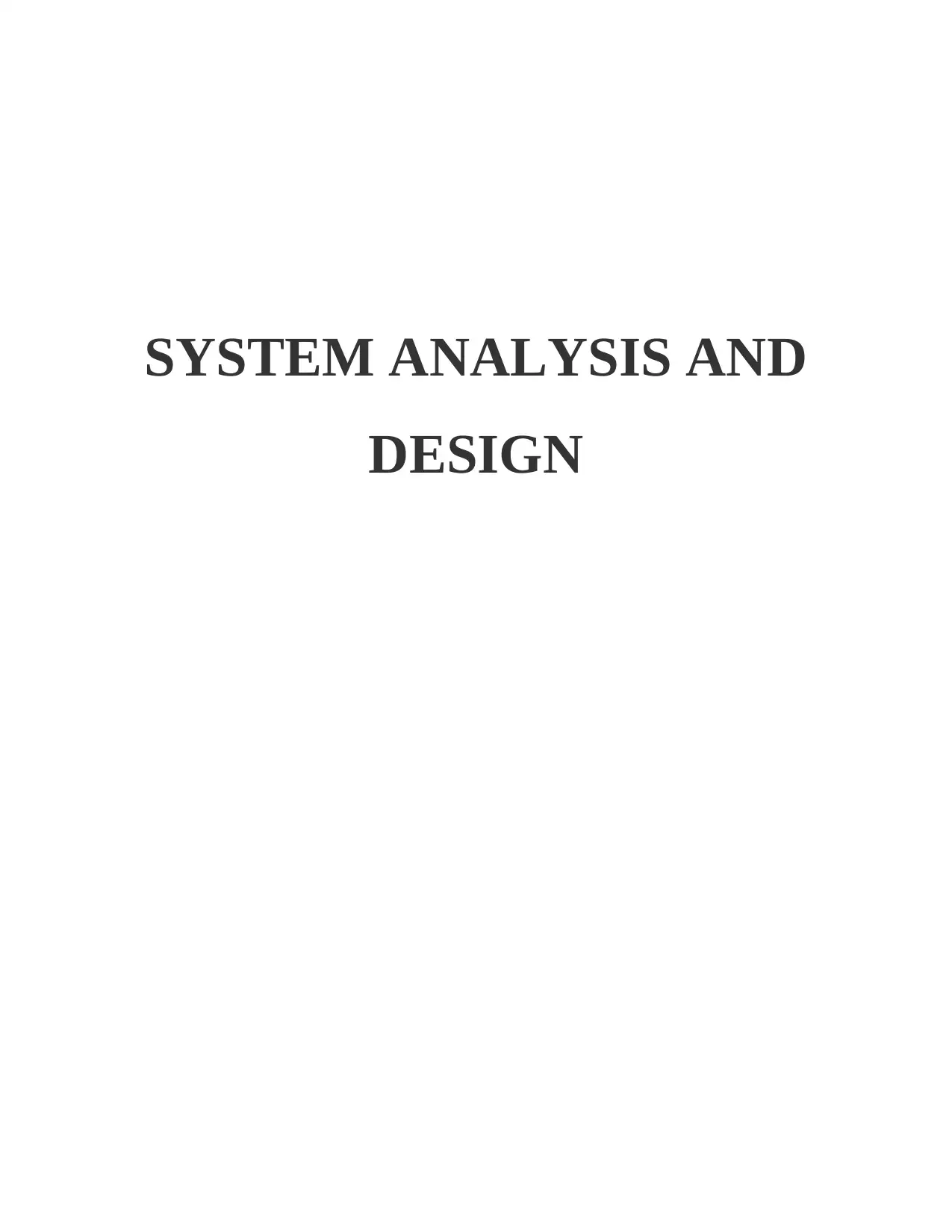
SYSTEM ANALYSIS AND
DESIGN
DESIGN
Paraphrase This Document
Need a fresh take? Get an instant paraphrase of this document with our AI Paraphraser
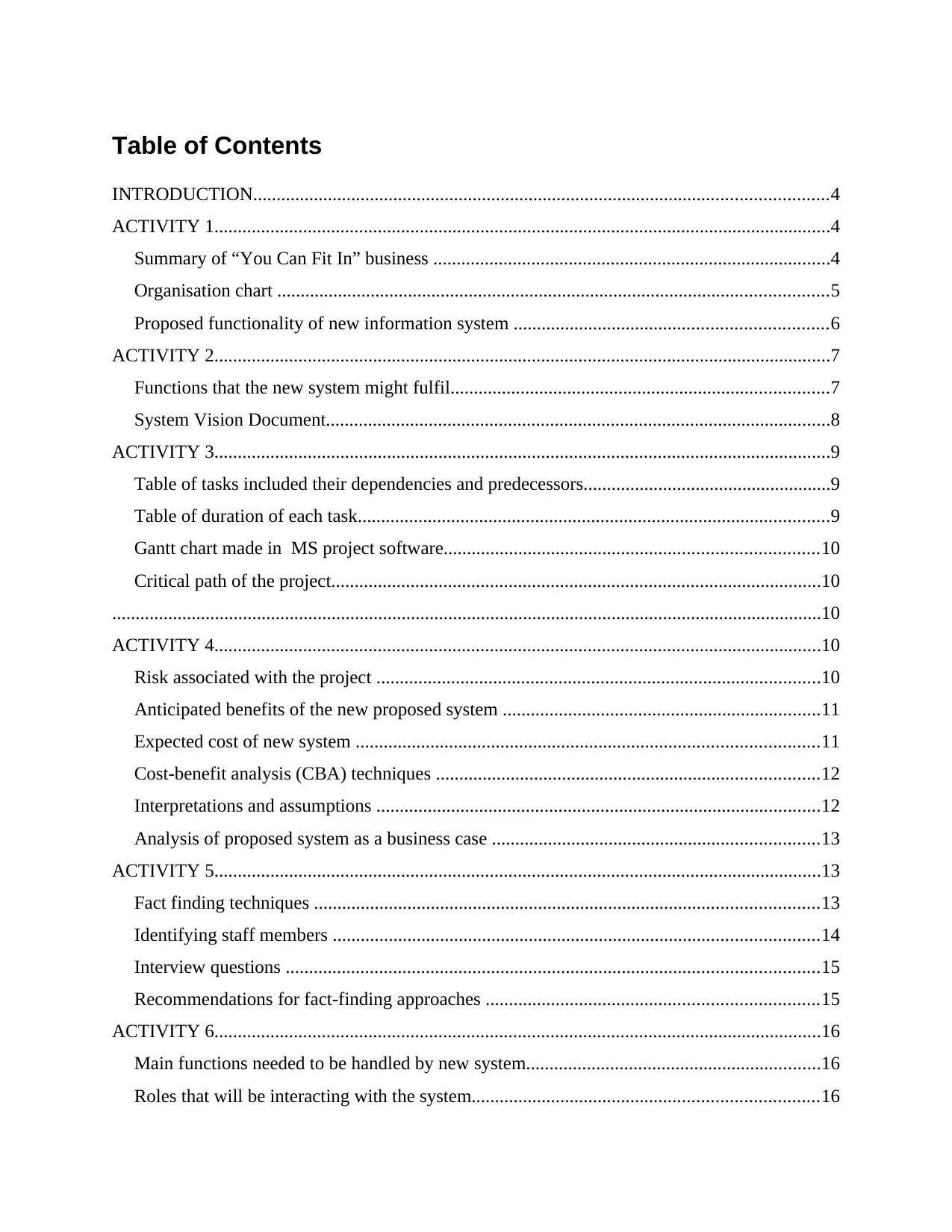
Table of Contents
INTRODUCTION...........................................................................................................................4
ACTIVITY 1....................................................................................................................................4
Summary of “You Can Fit In” business .....................................................................................4
Organisation chart ......................................................................................................................5
Proposed functionality of new information system ...................................................................6
ACTIVITY 2....................................................................................................................................7
Functions that the new system might fulfil.................................................................................7
System Vision Document............................................................................................................8
ACTIVITY 3....................................................................................................................................9
Table of tasks included their dependencies and predecessors.....................................................9
Table of duration of each task.....................................................................................................9
Gantt chart made in MS project software................................................................................10
Critical path of the project.........................................................................................................10
........................................................................................................................................................10
ACTIVITY 4..................................................................................................................................10
Risk associated with the project ...............................................................................................10
Anticipated benefits of the new proposed system ....................................................................11
Expected cost of new system ...................................................................................................11
Cost-benefit analysis (CBA) techniques ..................................................................................12
Interpretations and assumptions ...............................................................................................12
Analysis of proposed system as a business case ......................................................................13
ACTIVITY 5..................................................................................................................................13
Fact finding techniques ............................................................................................................13
Identifying staff members ........................................................................................................14
Interview questions ..................................................................................................................15
Recommendations for fact-finding approaches .......................................................................15
ACTIVITY 6..................................................................................................................................16
Main functions needed to be handled by new system...............................................................16
Roles that will be interacting with the system..........................................................................16
INTRODUCTION...........................................................................................................................4
ACTIVITY 1....................................................................................................................................4
Summary of “You Can Fit In” business .....................................................................................4
Organisation chart ......................................................................................................................5
Proposed functionality of new information system ...................................................................6
ACTIVITY 2....................................................................................................................................7
Functions that the new system might fulfil.................................................................................7
System Vision Document............................................................................................................8
ACTIVITY 3....................................................................................................................................9
Table of tasks included their dependencies and predecessors.....................................................9
Table of duration of each task.....................................................................................................9
Gantt chart made in MS project software................................................................................10
Critical path of the project.........................................................................................................10
........................................................................................................................................................10
ACTIVITY 4..................................................................................................................................10
Risk associated with the project ...............................................................................................10
Anticipated benefits of the new proposed system ....................................................................11
Expected cost of new system ...................................................................................................11
Cost-benefit analysis (CBA) techniques ..................................................................................12
Interpretations and assumptions ...............................................................................................12
Analysis of proposed system as a business case ......................................................................13
ACTIVITY 5..................................................................................................................................13
Fact finding techniques ............................................................................................................13
Identifying staff members ........................................................................................................14
Interview questions ..................................................................................................................15
Recommendations for fact-finding approaches .......................................................................15
ACTIVITY 6..................................................................................................................................16
Main functions needed to be handled by new system...............................................................16
Roles that will be interacting with the system..........................................................................16
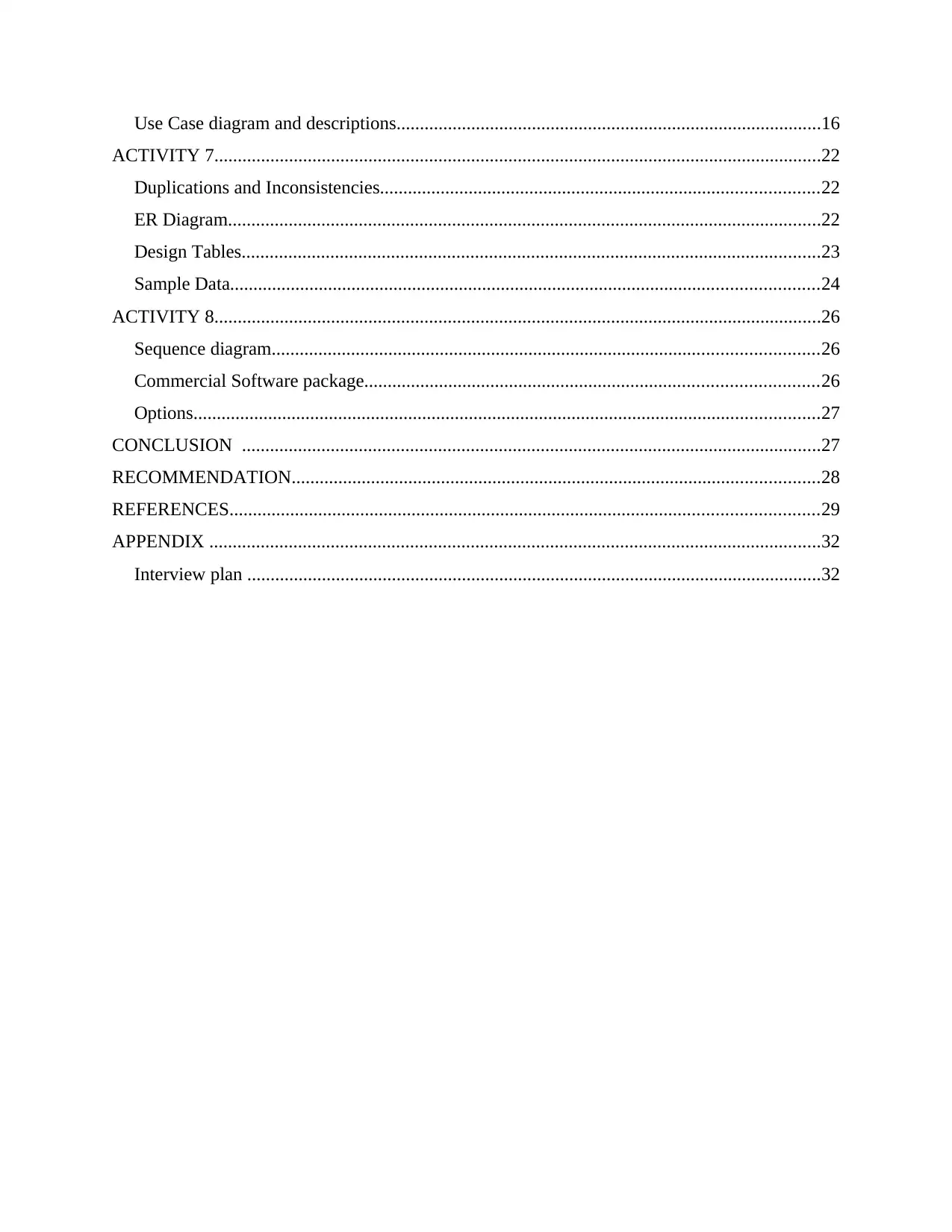
Use Case diagram and descriptions...........................................................................................16
ACTIVITY 7..................................................................................................................................22
Duplications and Inconsistencies..............................................................................................22
ER Diagram...............................................................................................................................22
Design Tables............................................................................................................................23
Sample Data..............................................................................................................................24
ACTIVITY 8..................................................................................................................................26
Sequence diagram.....................................................................................................................26
Commercial Software package.................................................................................................26
Options......................................................................................................................................27
CONCLUSION ............................................................................................................................27
RECOMMENDATION.................................................................................................................28
REFERENCES..............................................................................................................................29
APPENDIX ...................................................................................................................................32
Interview plan ...........................................................................................................................32
ACTIVITY 7..................................................................................................................................22
Duplications and Inconsistencies..............................................................................................22
ER Diagram...............................................................................................................................22
Design Tables............................................................................................................................23
Sample Data..............................................................................................................................24
ACTIVITY 8..................................................................................................................................26
Sequence diagram.....................................................................................................................26
Commercial Software package.................................................................................................26
Options......................................................................................................................................27
CONCLUSION ............................................................................................................................27
RECOMMENDATION.................................................................................................................28
REFERENCES..............................................................................................................................29
APPENDIX ...................................................................................................................................32
Interview plan ...........................................................................................................................32
⊘ This is a preview!⊘
Do you want full access?
Subscribe today to unlock all pages.

Trusted by 1+ million students worldwide
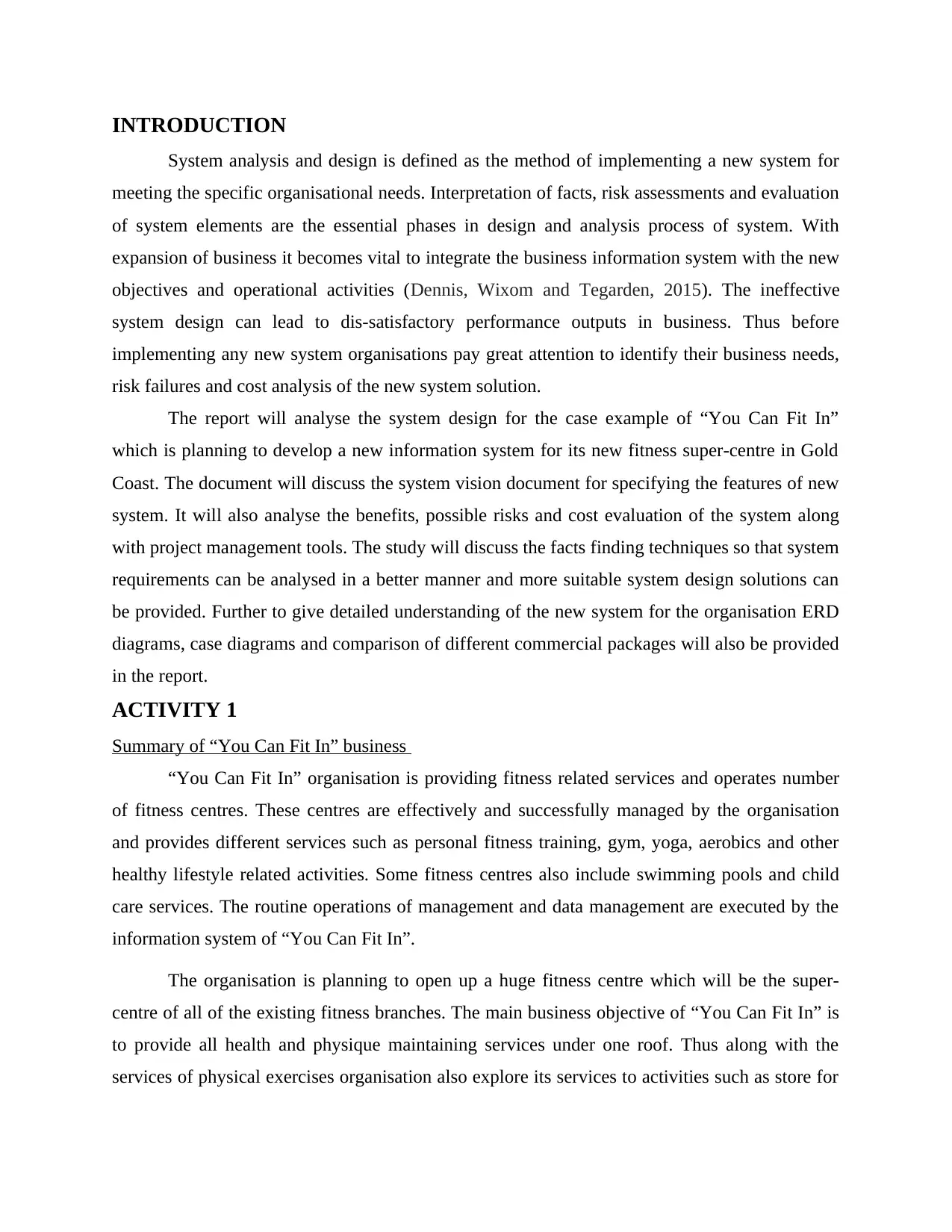
INTRODUCTION
System analysis and design is defined as the method of implementing a new system for
meeting the specific organisational needs. Interpretation of facts, risk assessments and evaluation
of system elements are the essential phases in design and analysis process of system. With
expansion of business it becomes vital to integrate the business information system with the new
objectives and operational activities (Dennis, Wixom and Tegarden, 2015). The ineffective
system design can lead to dis-satisfactory performance outputs in business. Thus before
implementing any new system organisations pay great attention to identify their business needs,
risk failures and cost analysis of the new system solution.
The report will analyse the system design for the case example of “You Can Fit In”
which is planning to develop a new information system for its new fitness super-centre in Gold
Coast. The document will discuss the system vision document for specifying the features of new
system. It will also analyse the benefits, possible risks and cost evaluation of the system along
with project management tools. The study will discuss the facts finding techniques so that system
requirements can be analysed in a better manner and more suitable system design solutions can
be provided. Further to give detailed understanding of the new system for the organisation ERD
diagrams, case diagrams and comparison of different commercial packages will also be provided
in the report.
ACTIVITY 1
Summary of “You Can Fit In” business
“You Can Fit In” organisation is providing fitness related services and operates number
of fitness centres. These centres are effectively and successfully managed by the organisation
and provides different services such as personal fitness training, gym, yoga, aerobics and other
healthy lifestyle related activities. Some fitness centres also include swimming pools and child
care services. The routine operations of management and data management are executed by the
information system of “You Can Fit In”.
The organisation is planning to open up a huge fitness centre which will be the super-
centre of all of the existing fitness branches. The main business objective of “You Can Fit In” is
to provide all health and physique maintaining services under one roof. Thus along with the
services of physical exercises organisation also explore its services to activities such as store for
System analysis and design is defined as the method of implementing a new system for
meeting the specific organisational needs. Interpretation of facts, risk assessments and evaluation
of system elements are the essential phases in design and analysis process of system. With
expansion of business it becomes vital to integrate the business information system with the new
objectives and operational activities (Dennis, Wixom and Tegarden, 2015). The ineffective
system design can lead to dis-satisfactory performance outputs in business. Thus before
implementing any new system organisations pay great attention to identify their business needs,
risk failures and cost analysis of the new system solution.
The report will analyse the system design for the case example of “You Can Fit In”
which is planning to develop a new information system for its new fitness super-centre in Gold
Coast. The document will discuss the system vision document for specifying the features of new
system. It will also analyse the benefits, possible risks and cost evaluation of the system along
with project management tools. The study will discuss the facts finding techniques so that system
requirements can be analysed in a better manner and more suitable system design solutions can
be provided. Further to give detailed understanding of the new system for the organisation ERD
diagrams, case diagrams and comparison of different commercial packages will also be provided
in the report.
ACTIVITY 1
Summary of “You Can Fit In” business
“You Can Fit In” organisation is providing fitness related services and operates number
of fitness centres. These centres are effectively and successfully managed by the organisation
and provides different services such as personal fitness training, gym, yoga, aerobics and other
healthy lifestyle related activities. Some fitness centres also include swimming pools and child
care services. The routine operations of management and data management are executed by the
information system of “You Can Fit In”.
The organisation is planning to open up a huge fitness centre which will be the super-
centre of all of the existing fitness branches. The main business objective of “You Can Fit In” is
to provide all health and physique maintaining services under one roof. Thus along with the
services of physical exercises organisation also explore its services to activities such as store for
Paraphrase This Document
Need a fresh take? Get an instant paraphrase of this document with our AI Paraphraser
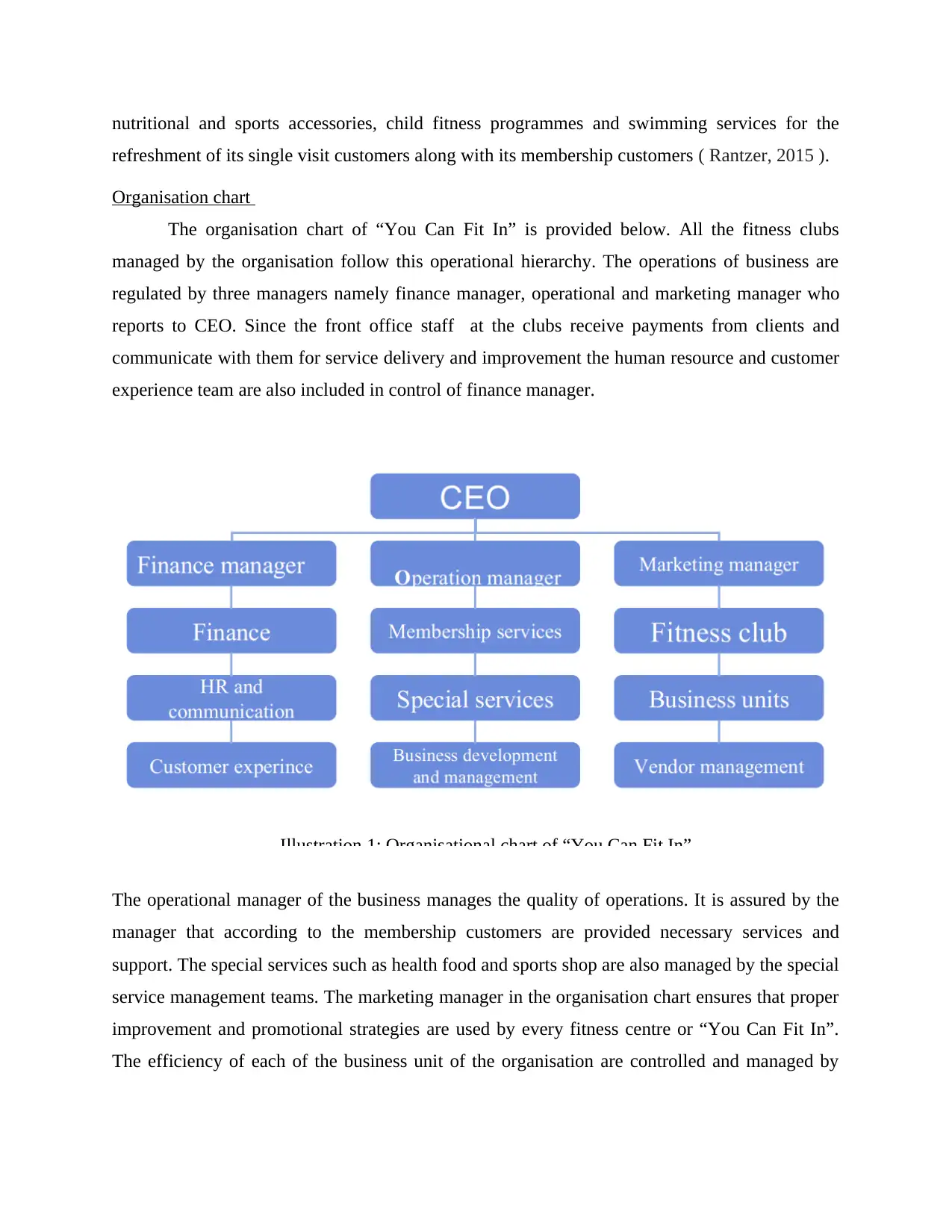
nutritional and sports accessories, child fitness programmes and swimming services for the
refreshment of its single visit customers along with its membership customers ( Rantzer, 2015 ).
Organisation chart
The organisation chart of “You Can Fit In” is provided below. All the fitness clubs
managed by the organisation follow this operational hierarchy. The operations of business are
regulated by three managers namely finance manager, operational and marketing manager who
reports to CEO. Since the front office staff at the clubs receive payments from clients and
communicate with them for service delivery and improvement the human resource and customer
experience team are also included in control of finance manager.
The operational manager of the business manages the quality of operations. It is assured by the
manager that according to the membership customers are provided necessary services and
support. The special services such as health food and sports shop are also managed by the special
service management teams. The marketing manager in the organisation chart ensures that proper
improvement and promotional strategies are used by every fitness centre or “You Can Fit In”.
The efficiency of each of the business unit of the organisation are controlled and managed by
Illustration 1: Organisational chart of “You Can Fit In”
refreshment of its single visit customers along with its membership customers ( Rantzer, 2015 ).
Organisation chart
The organisation chart of “You Can Fit In” is provided below. All the fitness clubs
managed by the organisation follow this operational hierarchy. The operations of business are
regulated by three managers namely finance manager, operational and marketing manager who
reports to CEO. Since the front office staff at the clubs receive payments from clients and
communicate with them for service delivery and improvement the human resource and customer
experience team are also included in control of finance manager.
The operational manager of the business manages the quality of operations. It is assured by the
manager that according to the membership customers are provided necessary services and
support. The special services such as health food and sports shop are also managed by the special
service management teams. The marketing manager in the organisation chart ensures that proper
improvement and promotional strategies are used by every fitness centre or “You Can Fit In”.
The efficiency of each of the business unit of the organisation are controlled and managed by
Illustration 1: Organisational chart of “You Can Fit In”
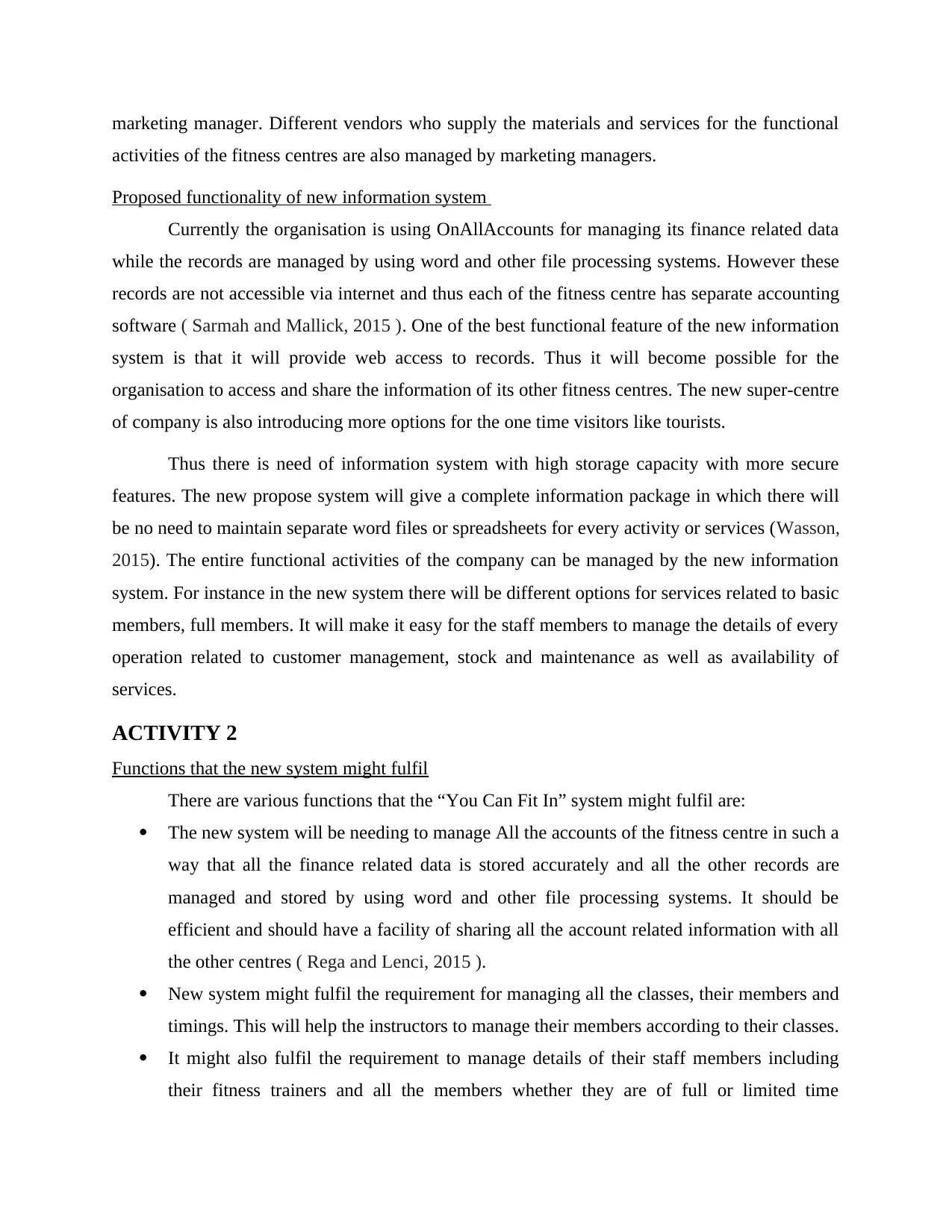
marketing manager. Different vendors who supply the materials and services for the functional
activities of the fitness centres are also managed by marketing managers.
Proposed functionality of new information system
Currently the organisation is using OnAllAccounts for managing its finance related data
while the records are managed by using word and other file processing systems. However these
records are not accessible via internet and thus each of the fitness centre has separate accounting
software ( Sarmah and Mallick, 2015 ). One of the best functional feature of the new information
system is that it will provide web access to records. Thus it will become possible for the
organisation to access and share the information of its other fitness centres. The new super-centre
of company is also introducing more options for the one time visitors like tourists.
Thus there is need of information system with high storage capacity with more secure
features. The new propose system will give a complete information package in which there will
be no need to maintain separate word files or spreadsheets for every activity or services (Wasson,
2015). The entire functional activities of the company can be managed by the new information
system. For instance in the new system there will be different options for services related to basic
members, full members. It will make it easy for the staff members to manage the details of every
operation related to customer management, stock and maintenance as well as availability of
services.
ACTIVITY 2
Functions that the new system might fulfil
There are various functions that the “You Can Fit In” system might fulfil are:
The new system will be needing to manage All the accounts of the fitness centre in such a
way that all the finance related data is stored accurately and all the other records are
managed and stored by using word and other file processing systems. It should be
efficient and should have a facility of sharing all the account related information with all
the other centres ( Rega and Lenci, 2015 ).
New system might fulfil the requirement for managing all the classes, their members and
timings. This will help the instructors to manage their members according to their classes.
It might also fulfil the requirement to manage details of their staff members including
their fitness trainers and all the members whether they are of full or limited time
activities of the fitness centres are also managed by marketing managers.
Proposed functionality of new information system
Currently the organisation is using OnAllAccounts for managing its finance related data
while the records are managed by using word and other file processing systems. However these
records are not accessible via internet and thus each of the fitness centre has separate accounting
software ( Sarmah and Mallick, 2015 ). One of the best functional feature of the new information
system is that it will provide web access to records. Thus it will become possible for the
organisation to access and share the information of its other fitness centres. The new super-centre
of company is also introducing more options for the one time visitors like tourists.
Thus there is need of information system with high storage capacity with more secure
features. The new propose system will give a complete information package in which there will
be no need to maintain separate word files or spreadsheets for every activity or services (Wasson,
2015). The entire functional activities of the company can be managed by the new information
system. For instance in the new system there will be different options for services related to basic
members, full members. It will make it easy for the staff members to manage the details of every
operation related to customer management, stock and maintenance as well as availability of
services.
ACTIVITY 2
Functions that the new system might fulfil
There are various functions that the “You Can Fit In” system might fulfil are:
The new system will be needing to manage All the accounts of the fitness centre in such a
way that all the finance related data is stored accurately and all the other records are
managed and stored by using word and other file processing systems. It should be
efficient and should have a facility of sharing all the account related information with all
the other centres ( Rega and Lenci, 2015 ).
New system might fulfil the requirement for managing all the classes, their members and
timings. This will help the instructors to manage their members according to their classes.
It might also fulfil the requirement to manage details of their staff members including
their fitness trainers and all the members whether they are of full or limited time
⊘ This is a preview!⊘
Do you want full access?
Subscribe today to unlock all pages.

Trusted by 1+ million students worldwide
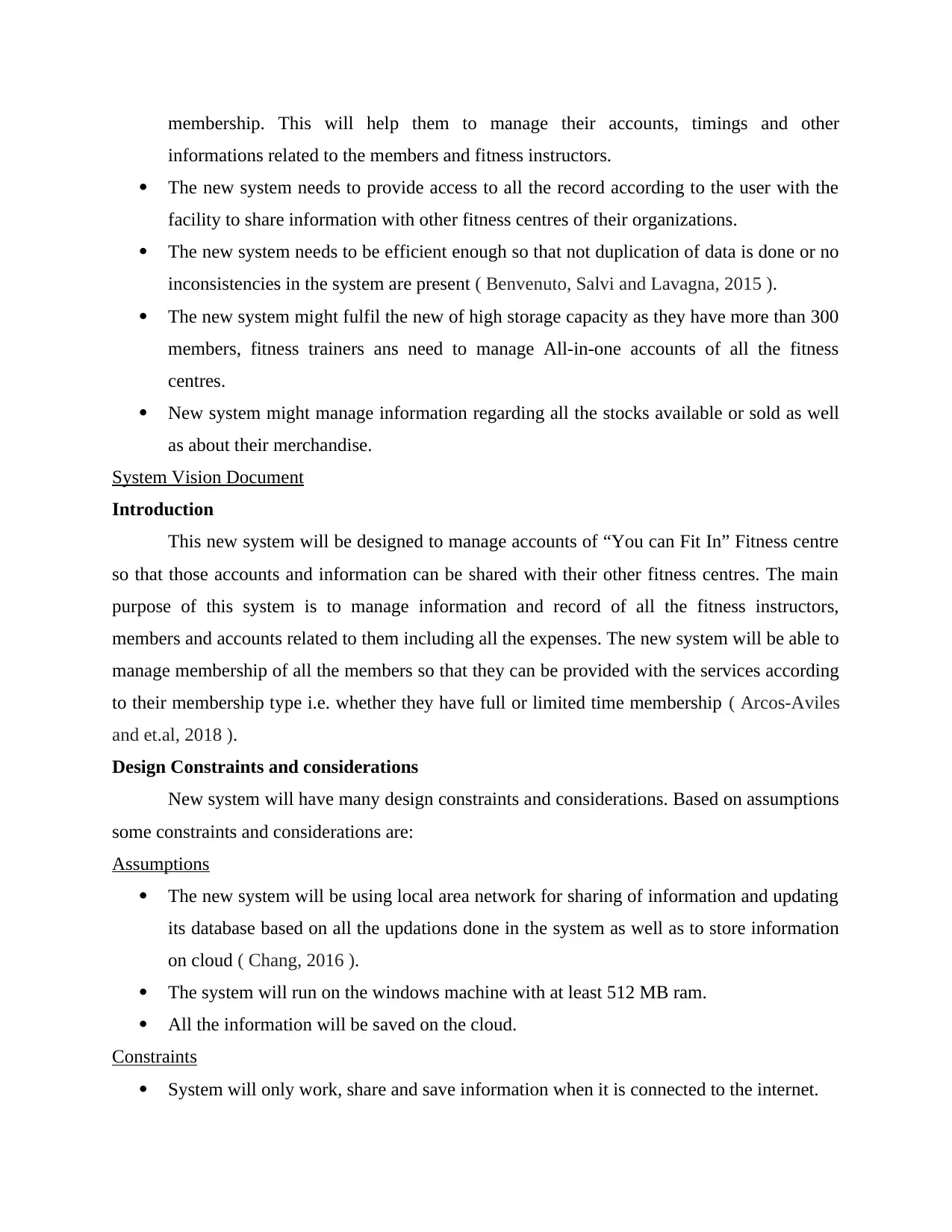
membership. This will help them to manage their accounts, timings and other
informations related to the members and fitness instructors.
The new system needs to provide access to all the record according to the user with the
facility to share information with other fitness centres of their organizations.
The new system needs to be efficient enough so that not duplication of data is done or no
inconsistencies in the system are present ( Benvenuto, Salvi and Lavagna, 2015 ).
The new system might fulfil the new of high storage capacity as they have more than 300
members, fitness trainers ans need to manage All-in-one accounts of all the fitness
centres.
New system might manage information regarding all the stocks available or sold as well
as about their merchandise.
System Vision Document
Introduction
This new system will be designed to manage accounts of “You can Fit In” Fitness centre
so that those accounts and information can be shared with their other fitness centres. The main
purpose of this system is to manage information and record of all the fitness instructors,
members and accounts related to them including all the expenses. The new system will be able to
manage membership of all the members so that they can be provided with the services according
to their membership type i.e. whether they have full or limited time membership ( Arcos-Aviles
and et.al, 2018 ).
Design Constraints and considerations
New system will have many design constraints and considerations. Based on assumptions
some constraints and considerations are:
Assumptions
The new system will be using local area network for sharing of information and updating
its database based on all the updations done in the system as well as to store information
on cloud ( Chang, 2016 ).
The system will run on the windows machine with at least 512 MB ram.
All the information will be saved on the cloud.
Constraints
System will only work, share and save information when it is connected to the internet.
informations related to the members and fitness instructors.
The new system needs to provide access to all the record according to the user with the
facility to share information with other fitness centres of their organizations.
The new system needs to be efficient enough so that not duplication of data is done or no
inconsistencies in the system are present ( Benvenuto, Salvi and Lavagna, 2015 ).
The new system might fulfil the new of high storage capacity as they have more than 300
members, fitness trainers ans need to manage All-in-one accounts of all the fitness
centres.
New system might manage information regarding all the stocks available or sold as well
as about their merchandise.
System Vision Document
Introduction
This new system will be designed to manage accounts of “You can Fit In” Fitness centre
so that those accounts and information can be shared with their other fitness centres. The main
purpose of this system is to manage information and record of all the fitness instructors,
members and accounts related to them including all the expenses. The new system will be able to
manage membership of all the members so that they can be provided with the services according
to their membership type i.e. whether they have full or limited time membership ( Arcos-Aviles
and et.al, 2018 ).
Design Constraints and considerations
New system will have many design constraints and considerations. Based on assumptions
some constraints and considerations are:
Assumptions
The new system will be using local area network for sharing of information and updating
its database based on all the updations done in the system as well as to store information
on cloud ( Chang, 2016 ).
The system will run on the windows machine with at least 512 MB ram.
All the information will be saved on the cloud.
Constraints
System will only work, share and save information when it is connected to the internet.
Paraphrase This Document
Need a fresh take? Get an instant paraphrase of this document with our AI Paraphraser
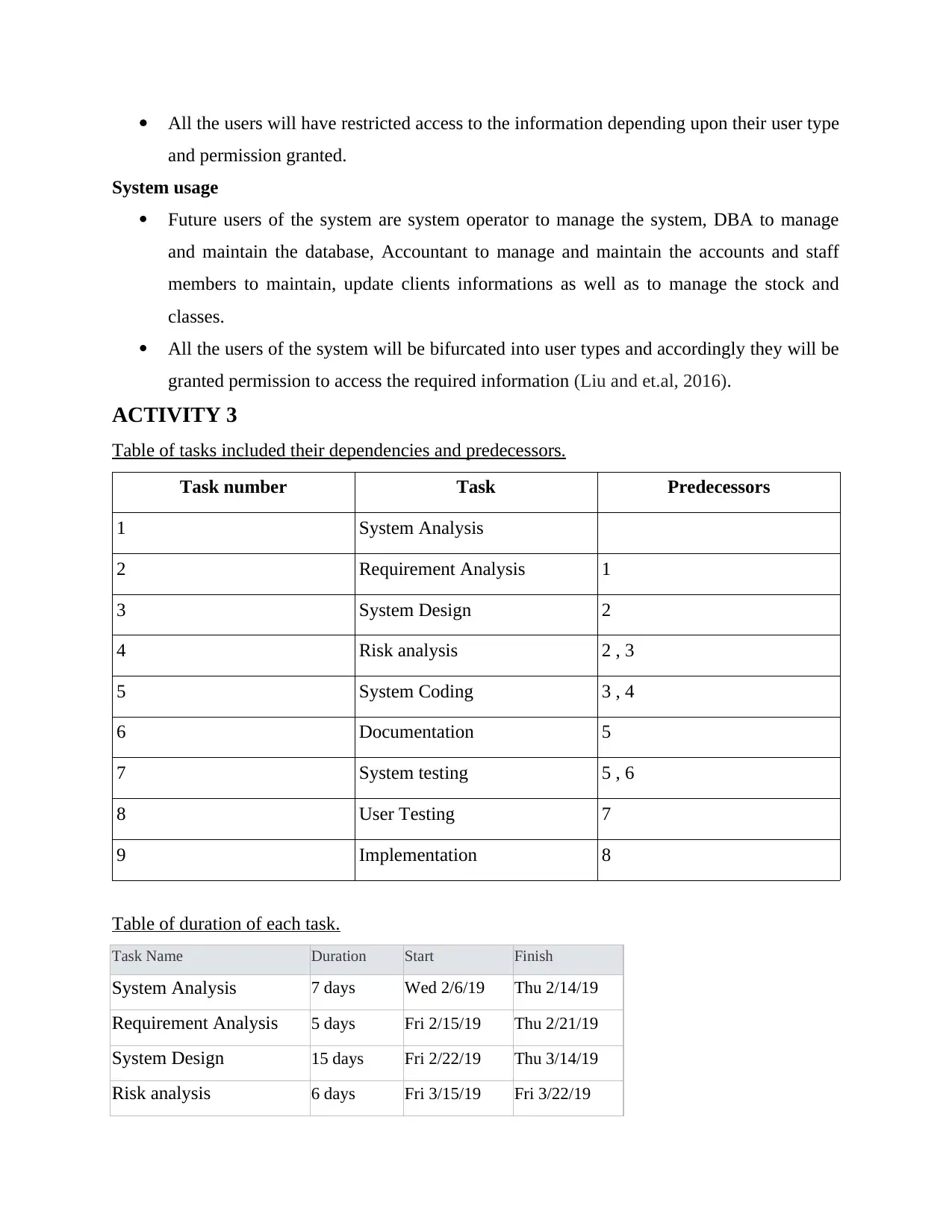
All the users will have restricted access to the information depending upon their user type
and permission granted.
System usage
Future users of the system are system operator to manage the system, DBA to manage
and maintain the database, Accountant to manage and maintain the accounts and staff
members to maintain, update clients informations as well as to manage the stock and
classes.
All the users of the system will be bifurcated into user types and accordingly they will be
granted permission to access the required information (Liu and et.al, 2016).
ACTIVITY 3
Table of tasks included their dependencies and predecessors.
Task number Task Predecessors
1 System Analysis
2 Requirement Analysis 1
3 System Design 2
4 Risk analysis 2 , 3
5 System Coding 3 , 4
6 Documentation 5
7 System testing 5 , 6
8 User Testing 7
9 Implementation 8
Table of duration of each task.
Task Name Duration Start Finish
System Analysis 7 days Wed 2/6/19 Thu 2/14/19
Requirement Analysis 5 days Fri 2/15/19 Thu 2/21/19
System Design 15 days Fri 2/22/19 Thu 3/14/19
Risk analysis 6 days Fri 3/15/19 Fri 3/22/19
and permission granted.
System usage
Future users of the system are system operator to manage the system, DBA to manage
and maintain the database, Accountant to manage and maintain the accounts and staff
members to maintain, update clients informations as well as to manage the stock and
classes.
All the users of the system will be bifurcated into user types and accordingly they will be
granted permission to access the required information (Liu and et.al, 2016).
ACTIVITY 3
Table of tasks included their dependencies and predecessors.
Task number Task Predecessors
1 System Analysis
2 Requirement Analysis 1
3 System Design 2
4 Risk analysis 2 , 3
5 System Coding 3 , 4
6 Documentation 5
7 System testing 5 , 6
8 User Testing 7
9 Implementation 8
Table of duration of each task.
Task Name Duration Start Finish
System Analysis 7 days Wed 2/6/19 Thu 2/14/19
Requirement Analysis 5 days Fri 2/15/19 Thu 2/21/19
System Design 15 days Fri 2/22/19 Thu 3/14/19
Risk analysis 6 days Fri 3/15/19 Fri 3/22/19
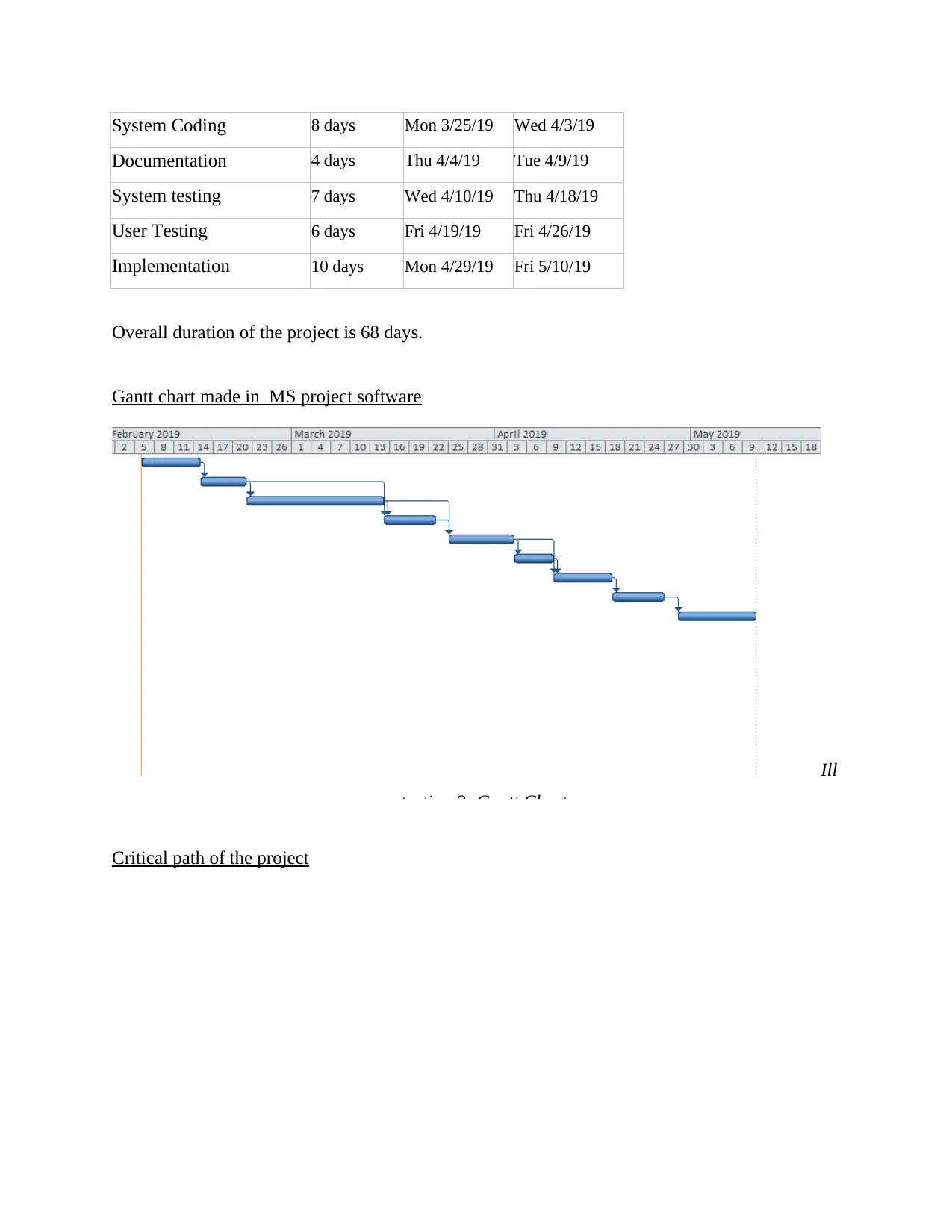
System Coding 8 days Mon 3/25/19 Wed 4/3/19
Documentation 4 days Thu 4/4/19 Tue 4/9/19
System testing 7 days Wed 4/10/19 Thu 4/18/19
User Testing 6 days Fri 4/19/19 Fri 4/26/19
Implementation 10 days Mon 4/29/19 Fri 5/10/19
Overall duration of the project is 68 days.
Gantt chart made in MS project software
Ill
ustration 2: Gantt Chart
Critical path of the project
Documentation 4 days Thu 4/4/19 Tue 4/9/19
System testing 7 days Wed 4/10/19 Thu 4/18/19
User Testing 6 days Fri 4/19/19 Fri 4/26/19
Implementation 10 days Mon 4/29/19 Fri 5/10/19
Overall duration of the project is 68 days.
Gantt chart made in MS project software
Ill
ustration 2: Gantt Chart
Critical path of the project
⊘ This is a preview!⊘
Do you want full access?
Subscribe today to unlock all pages.

Trusted by 1+ million students worldwide
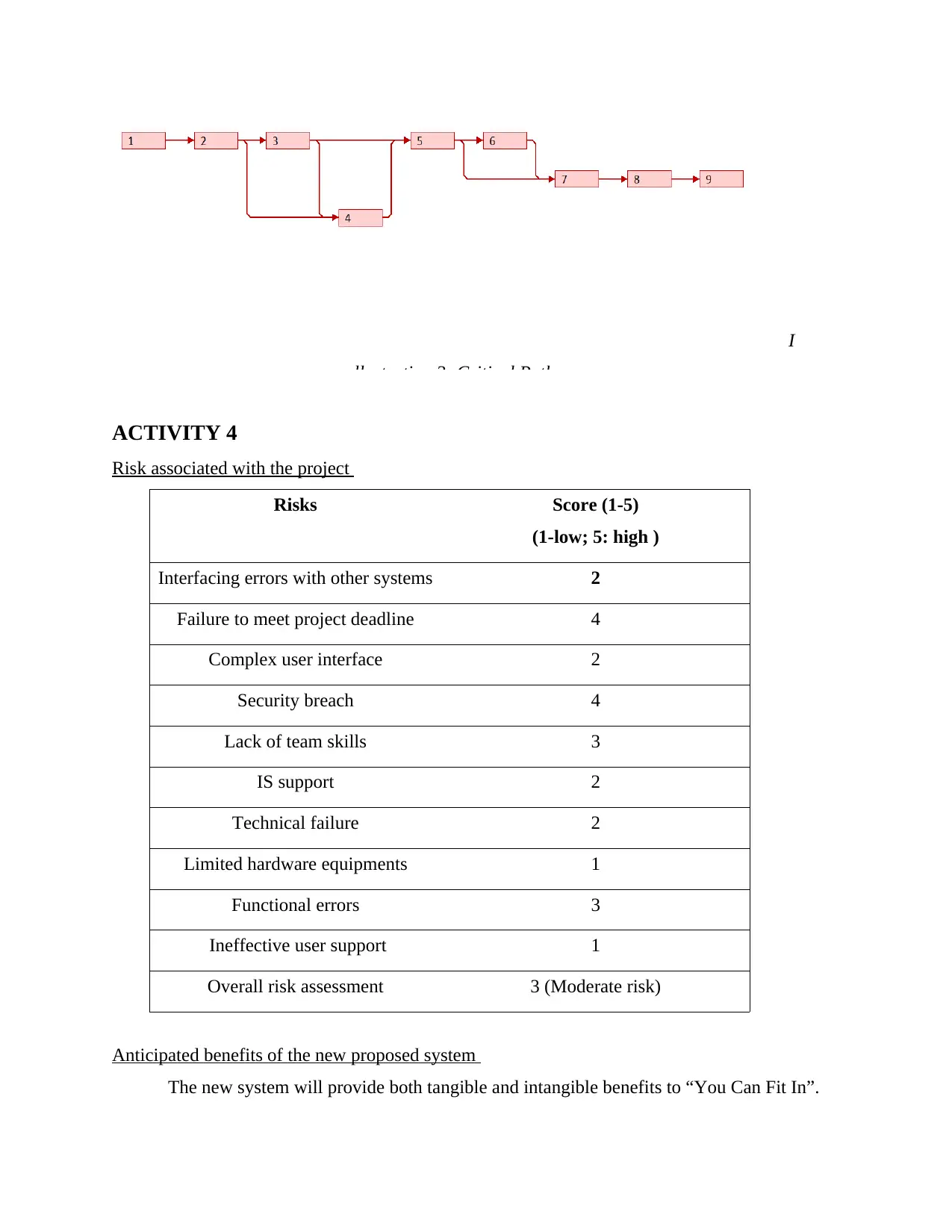
I
llustration 3: Critical Path
ACTIVITY 4
Risk associated with the project
Risks Score (1-5)
(1-low; 5: high )
Interfacing errors with other systems 2
Failure to meet project deadline 4
Complex user interface 2
Security breach 4
Lack of team skills 3
IS support 2
Technical failure 2
Limited hardware equipments 1
Functional errors 3
Ineffective user support 1
Overall risk assessment 3 (Moderate risk)
Anticipated benefits of the new proposed system
The new system will provide both tangible and intangible benefits to “You Can Fit In”.
llustration 3: Critical Path
ACTIVITY 4
Risk associated with the project
Risks Score (1-5)
(1-low; 5: high )
Interfacing errors with other systems 2
Failure to meet project deadline 4
Complex user interface 2
Security breach 4
Lack of team skills 3
IS support 2
Technical failure 2
Limited hardware equipments 1
Functional errors 3
Ineffective user support 1
Overall risk assessment 3 (Moderate risk)
Anticipated benefits of the new proposed system
The new system will provide both tangible and intangible benefits to “You Can Fit In”.
Paraphrase This Document
Need a fresh take? Get an instant paraphrase of this document with our AI Paraphraser
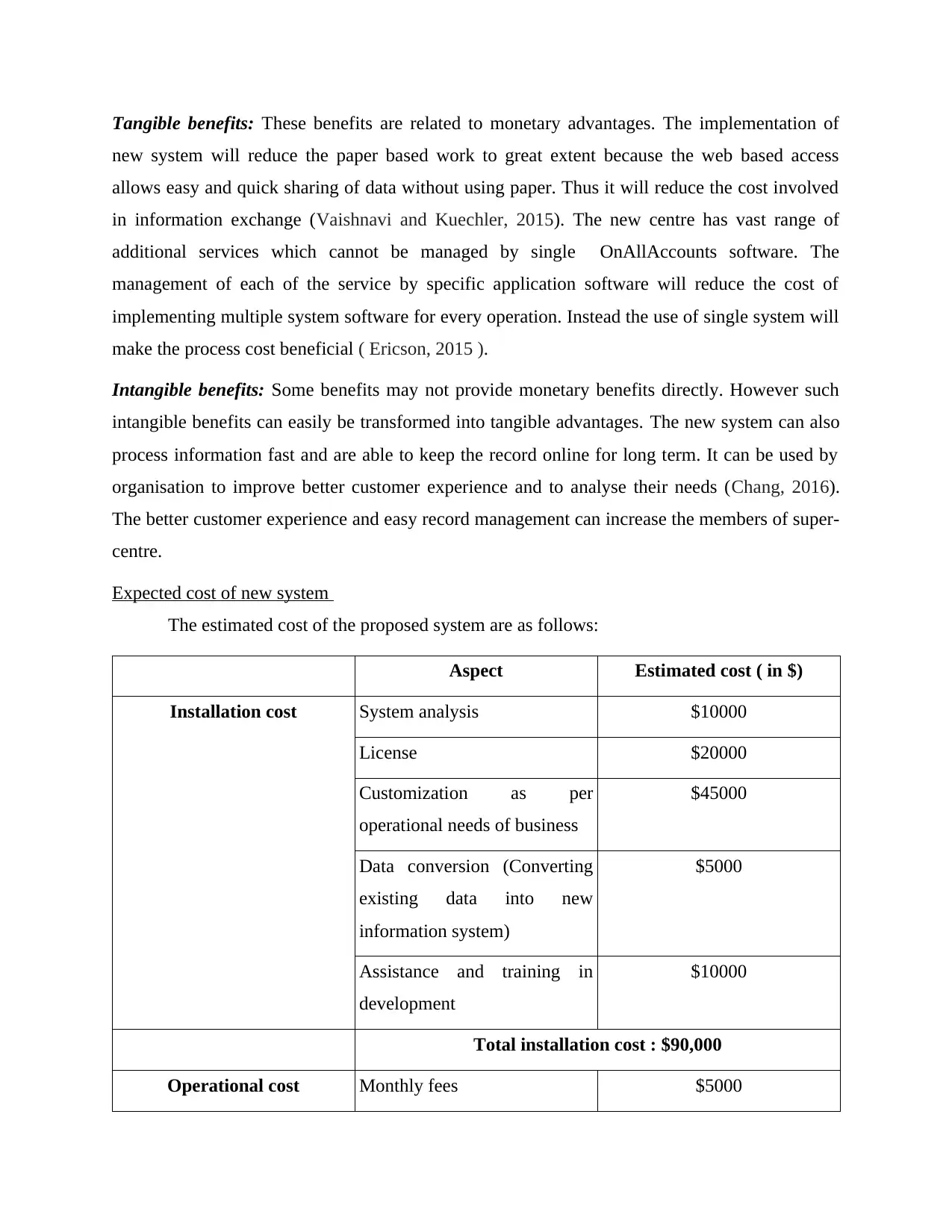
Tangible benefits: These benefits are related to monetary advantages. The implementation of
new system will reduce the paper based work to great extent because the web based access
allows easy and quick sharing of data without using paper. Thus it will reduce the cost involved
in information exchange (Vaishnavi and Kuechler, 2015). The new centre has vast range of
additional services which cannot be managed by single OnAllAccounts software. The
management of each of the service by specific application software will reduce the cost of
implementing multiple system software for every operation. Instead the use of single system will
make the process cost beneficial ( Ericson, 2015 ).
Intangible benefits: Some benefits may not provide monetary benefits directly. However such
intangible benefits can easily be transformed into tangible advantages. The new system can also
process information fast and are able to keep the record online for long term. It can be used by
organisation to improve better customer experience and to analyse their needs (Chang, 2016).
The better customer experience and easy record management can increase the members of super-
centre.
Expected cost of new system
The estimated cost of the proposed system are as follows:
Aspect Estimated cost ( in $)
Installation cost System analysis $10000
License $20000
Customization as per
operational needs of business
$45000
Data conversion (Converting
existing data into new
information system)
$5000
Assistance and training in
development
$10000
Total installation cost : $90,000
Operational cost Monthly fees $5000
new system will reduce the paper based work to great extent because the web based access
allows easy and quick sharing of data without using paper. Thus it will reduce the cost involved
in information exchange (Vaishnavi and Kuechler, 2015). The new centre has vast range of
additional services which cannot be managed by single OnAllAccounts software. The
management of each of the service by specific application software will reduce the cost of
implementing multiple system software for every operation. Instead the use of single system will
make the process cost beneficial ( Ericson, 2015 ).
Intangible benefits: Some benefits may not provide monetary benefits directly. However such
intangible benefits can easily be transformed into tangible advantages. The new system can also
process information fast and are able to keep the record online for long term. It can be used by
organisation to improve better customer experience and to analyse their needs (Chang, 2016).
The better customer experience and easy record management can increase the members of super-
centre.
Expected cost of new system
The estimated cost of the proposed system are as follows:
Aspect Estimated cost ( in $)
Installation cost System analysis $10000
License $20000
Customization as per
operational needs of business
$45000
Data conversion (Converting
existing data into new
information system)
$5000
Assistance and training in
development
$10000
Total installation cost : $90,000
Operational cost Monthly fees $5000
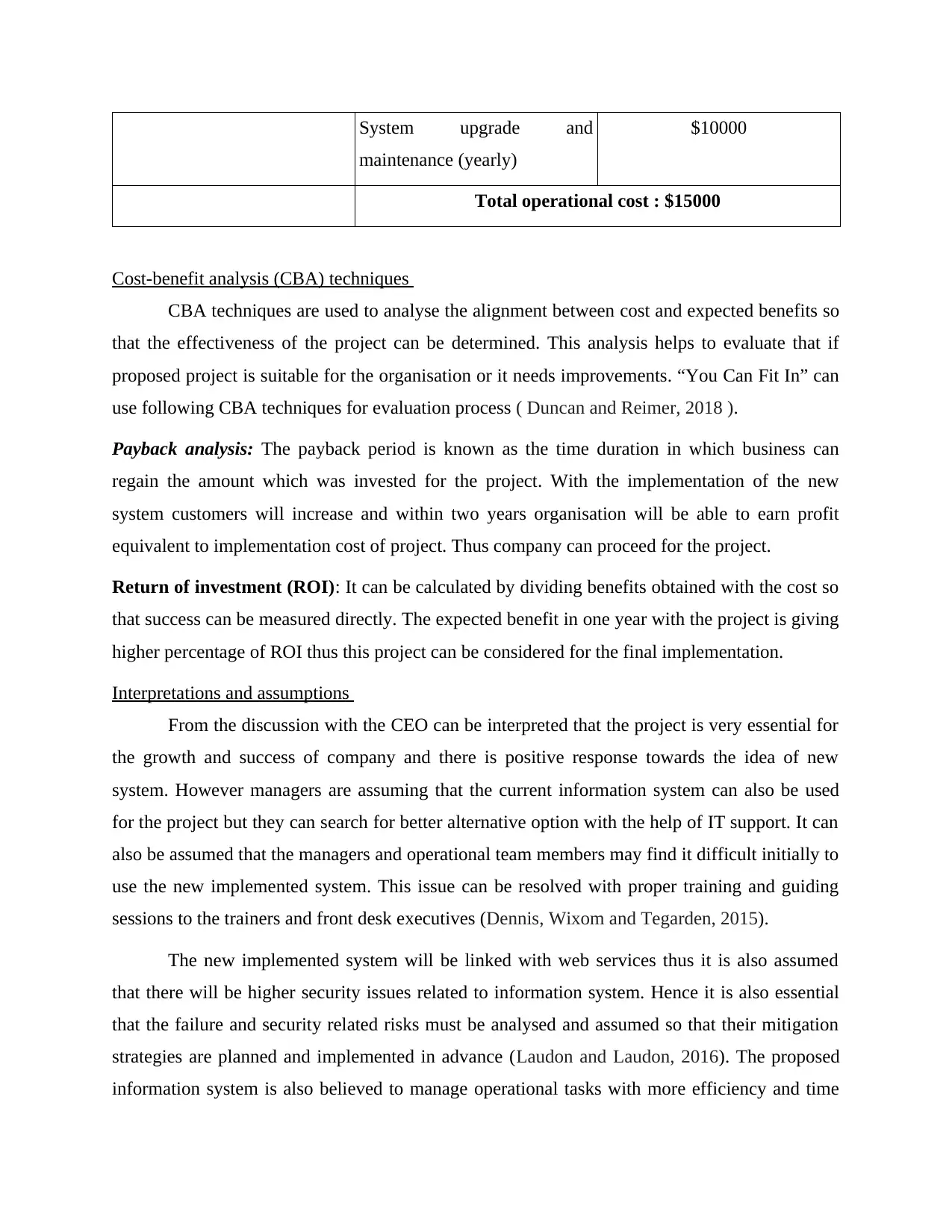
System upgrade and
maintenance (yearly)
$10000
Total operational cost : $15000
Cost-benefit analysis (CBA) techniques
CBA techniques are used to analyse the alignment between cost and expected benefits so
that the effectiveness of the project can be determined. This analysis helps to evaluate that if
proposed project is suitable for the organisation or it needs improvements. “You Can Fit In” can
use following CBA techniques for evaluation process ( Duncan and Reimer, 2018 ).
Payback analysis: The payback period is known as the time duration in which business can
regain the amount which was invested for the project. With the implementation of the new
system customers will increase and within two years organisation will be able to earn profit
equivalent to implementation cost of project. Thus company can proceed for the project.
Return of investment (ROI): It can be calculated by dividing benefits obtained with the cost so
that success can be measured directly. The expected benefit in one year with the project is giving
higher percentage of ROI thus this project can be considered for the final implementation.
Interpretations and assumptions
From the discussion with the CEO can be interpreted that the project is very essential for
the growth and success of company and there is positive response towards the idea of new
system. However managers are assuming that the current information system can also be used
for the project but they can search for better alternative option with the help of IT support. It can
also be assumed that the managers and operational team members may find it difficult initially to
use the new implemented system. This issue can be resolved with proper training and guiding
sessions to the trainers and front desk executives (Dennis, Wixom and Tegarden, 2015).
The new implemented system will be linked with web services thus it is also assumed
that there will be higher security issues related to information system. Hence it is also essential
that the failure and security related risks must be analysed and assumed so that their mitigation
strategies are planned and implemented in advance (Laudon and Laudon, 2016). The proposed
information system is also believed to manage operational tasks with more efficiency and time
maintenance (yearly)
$10000
Total operational cost : $15000
Cost-benefit analysis (CBA) techniques
CBA techniques are used to analyse the alignment between cost and expected benefits so
that the effectiveness of the project can be determined. This analysis helps to evaluate that if
proposed project is suitable for the organisation or it needs improvements. “You Can Fit In” can
use following CBA techniques for evaluation process ( Duncan and Reimer, 2018 ).
Payback analysis: The payback period is known as the time duration in which business can
regain the amount which was invested for the project. With the implementation of the new
system customers will increase and within two years organisation will be able to earn profit
equivalent to implementation cost of project. Thus company can proceed for the project.
Return of investment (ROI): It can be calculated by dividing benefits obtained with the cost so
that success can be measured directly. The expected benefit in one year with the project is giving
higher percentage of ROI thus this project can be considered for the final implementation.
Interpretations and assumptions
From the discussion with the CEO can be interpreted that the project is very essential for
the growth and success of company and there is positive response towards the idea of new
system. However managers are assuming that the current information system can also be used
for the project but they can search for better alternative option with the help of IT support. It can
also be assumed that the managers and operational team members may find it difficult initially to
use the new implemented system. This issue can be resolved with proper training and guiding
sessions to the trainers and front desk executives (Dennis, Wixom and Tegarden, 2015).
The new implemented system will be linked with web services thus it is also assumed
that there will be higher security issues related to information system. Hence it is also essential
that the failure and security related risks must be analysed and assumed so that their mitigation
strategies are planned and implemented in advance (Laudon and Laudon, 2016). The proposed
information system is also believed to manage operational tasks with more efficiency and time
⊘ This is a preview!⊘
Do you want full access?
Subscribe today to unlock all pages.

Trusted by 1+ million students worldwide
1 out of 29
Related Documents
Your All-in-One AI-Powered Toolkit for Academic Success.
+13062052269
info@desklib.com
Available 24*7 on WhatsApp / Email
![[object Object]](/_next/static/media/star-bottom.7253800d.svg)
Unlock your academic potential
Copyright © 2020–2025 A2Z Services. All Rights Reserved. Developed and managed by ZUCOL.
